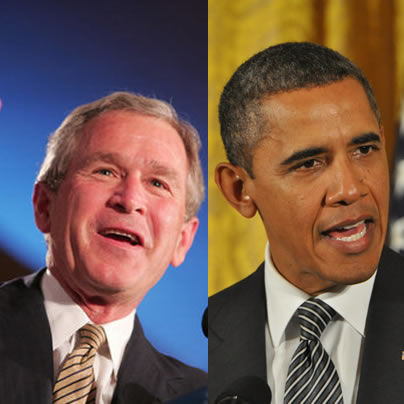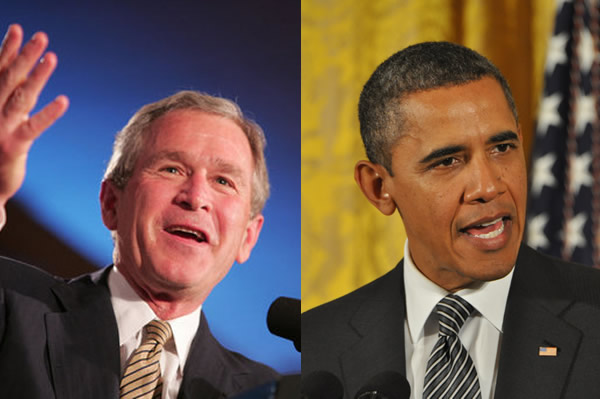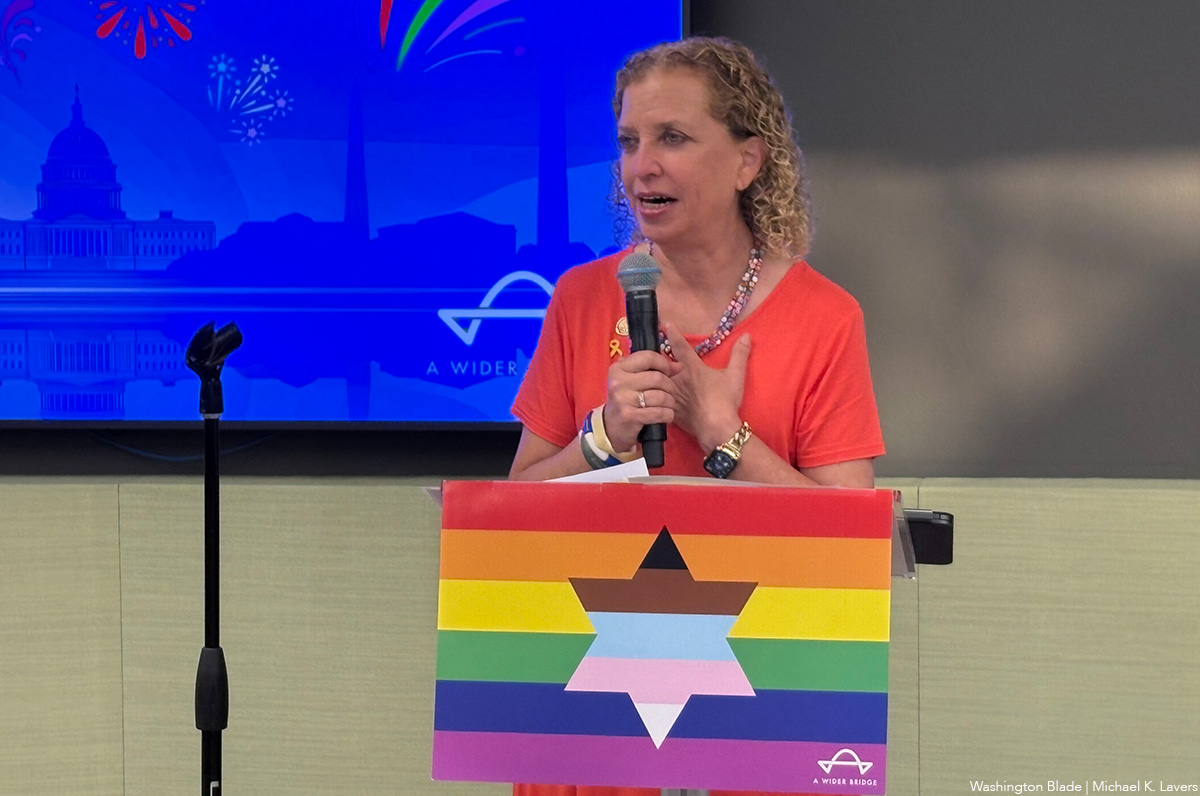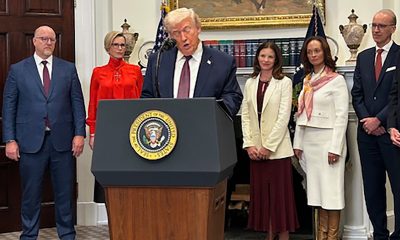National
Obama vs. Bush: Who’s done more on HIV/AIDS?
Lifting of HIV travel ban initiated by previous administration


Who’s done more on HIV/AIDS: George W. Bush or President Obama? (Bush photo public domain; Obama photo Blade photo by Michael Key)
HIV/AIDS advocates from around the world are descending on D.C. for the 19th International AIDS Conference with a shared goal: to eliminate a disease that has taken the lives of more than 25 million people worldwide.
Despite unity on this goal, politics inevitably plays a role in the response to the epidemic and advocates have widely differing views on who has done more in recent years to combat HIV/AIDS both at home and abroad: former President George W. Bush or President Obama.
Some praise the Obama administration for laying out a comprehensive plan and bumping up domestic funding to confront the epidemic, while others yearn for the Bush days because of the global initiatives the Republican president started despite his reputation for anti-gay policies.
Jim Driscoll, a gay Nevada-based HIV/AIDS activist who served on the Presidential Advisory Council on HIV/AIDS during the Bush administration, is among those who believes Bush did more to stop the epidemic.
“I never sat down and had a one-on-one conversation with him, but people who did talked about how open he was to doing things on AIDS and how interested he was in that subject,” Driscoll said. “There wasn’t anything the community asked him to do that I was involved in that he didn’t do.”
Those who say Bush has done more for HIV/AIDS identified three major initiatives under the Bush administration: the start of a program called the President’s Emergency Plan for AIDS Relief, or PEPFAR, to confront the global AIDS epidemic; streamlining fund allocation under the Ryan White Care Act to consider people who have HIV infection without full-blown AIDS; and allowing the first-ever rapid HIV tests to be used outside medical offices.
Driscoll, a Republican who’s backing GOP presumptive nominee Mitt Romney in the upcoming presidential election, recalled the process by which Bush approved rapid testing and said it was praised by many — with the exception of some Food & Drug Administration officials whom he overruled.
“It was a big step forward, and George Bush actually personally had a lot to do with that,” Driscoll said. “The president actually overruled FDA, and I was in the room when this was announced. There were about 100 people in the room, I think. I remember still that when he announced his approval of rapid testing … everybody in the room gave him a standing ovation except for the three people from FDA, who sat glumly. They didn’t applaud or anything.”
The AIDS Drug Assistance Programs under Bush didn’t see the waiting list levels that have been seen under the Obama administration. Under Obama, the waiting list last year reached an all-time high of 9,928 low-income people awaiting HIV drugs. That number has since dropped to about 2,000 today, according to the administration.
That’s not the only complaint that’s been lodged against Obama, who’s been criticized for reducing the global AIDS program that was set up by Bush. In his most recent budget request to Congress, the White House cut the program by half a billion dollars.
Michael Weinstein, president of the AIDS Healthcare Foundation, said HIV/AIDS was a “higher priority” for Bush than it is for Obama, citing the ADAP waiting list and the distinction in PEPFAR as a key difference between the presidents.
“We had practically no global AIDS program prior to President Bush taking office, and before he left office, they approved a $48 billion plan for PEPFAR, which Sen. Obama voted to authorize and enact,” Weinstein said. “This year, President Obama for the first time in the history of the program asked for less money for global AIDS than we had last year, and there’s $1.4 billion in unspent money in PEPFAR.”
However, the president’s most recent budget request includes an increase for domestic programs against HIV/AIDS: a $75 million increase for Ryan White and an increase of $67 million for ADAP from last year to eliminate waiting lists by 2013.
As for PEPFAR, the White House has maintained that the program is doing more with less by using generic drugs and shipping commodities more cheaply. On World AIDS Day, Obama announced he would fully fund the balance of the administration’s three-year, $4 billion pledge to the Global Fund to Fight AIDS, Tuberculosis, and Malaria.
Shin Inouye, a White House spokesperson, defended the administration’s work on HIV/AIDS by citing achievements as well as plans set into motion to confront the epidemic.
“President Obama and his administration are unwavering in their commitment to addressing the issue of HIV/AIDS — on both the domestic and global fronts,” Inouye said. “These include steps such as establishing and implementing the first comprehensive National HIV/AIDS Strategy, lifting the HIV entry ban, and strengthening the impact and sustainability of PEPFAR and the Global Fund to Fight AIDS, Tuberculosis, and Malaria.”
Obama’s signature legislative achievement, the Affordable Care Act, is also slated to have significant impact on people living with HIV. The Medicaid expansion under the health care reform law is expected to significantly expand coverage because half the people living with HIV already receive care through the program.
Carl Schmid, deputy executive director of the AIDS Institute, said Obama has “definitely” done more on HIV/AIDS — at least on the domestic front — in part because of his willingness to talk about how the disease impacts gay men.
“They are over 60 percent of the epidemic,” Schmid said. “Focusing on this community that has been ravaged by HIV, allowing a discussion and making gay people more acceptable — this could really turn the tide on HIV prevention for gay men. We have a president who is focusing on the community [and directing] resources that are more in line with how the epidemic is.”
In comparison, Bush took flak from HIV/AIDS advocates for not taking action on the epidemic in ways that might upset his conservative base. Among his actions: promoting abstinence-only sex education, opposing federal funds for needle exchange programs and remaining silent on gay men and condoms for much of his administration.
Michael Rajner, a gay Fort Lauderdale-based HIV/AIDS advocate who’s living with AIDS and has been selected as a delegate for the Democratic National Convention, said he thinks Obama has “absolutely” done more to fight HIV/AIDS based on a more science-based approach he’s taken against the disease.
“The difference between Republican and Democrat — in this case, George W. Bush and President Obama — is really the difference in thought, whether they’re going to be addressing HIV/AIDS through ideology or through science, and President Obama has certainly embraced the issues of science,” Rajner said.
One achievement often attributed to Obama is the lifting of the regulatory travel ban that prevented HIV-positive foreign nationals from entering the country — a move that enabled the International AIDS Conference to take place in the United States. But this process actually started under the Bush administration. Under Bush’s leadership, Congress repealed a law that barred HIV-positive foreign nationals from entering as part of the legislative package authorizing PEPFAR.
Schmid said he was “intimately involved” in the process under which Bush starting lifting the HIV travel ban.
“Credit goes to George Bush’s administration and the Congress for lifting the travel ban in reauthorization of PEPFAR,” Schmid said. “There still was a process at HHS, and Obama finished that process. It wasn’t completed in time, unfortunately, under President Bush, but they definitely lifted it congressionally.”
Driscoll said Bush should be commended because he accomplished work on HIV/AIDS despite being beholden to social conservatives who elected him to office.
“Every president, every politician is limited by his constituents, by the people who put him in office, who voted for him and the people he would depend upon to do the same thing should he run again,” Driscoll said. “You have to consider what a president does in terms of the limitations that are imposed. I think, given, the limitations that George Bush’s constituencies imposed, he showed real leadership.”
Federal Government
Holiday week brings setbacks for Trump-Vance trans agenda
Federal courts begin to deliver end-of-year responses to lawsuits involving federal transgender healthcare policy.

While many Americans took the week of Christmas to rest and relax, LGBTQ politics in the U.S. continued to shift. This week’s short recap of federal updates highlights two major blows to the Trump-Vance administration’s efforts to restrict gender-affirming care for minors.
19 states sue RFK Jr. to end gender-affirming care ban
New York Attorney General Letitia James announced on Tuesday that the NYAG’s office, along with 18 other states (and the District of Columbia), filed a lawsuit to stop U.S. Health and Human Services (HHS) Secretary Robert F. Kennedy Jr. from restricting gender-affirming care for minors.
In the press release, Attorney General James stressed that the push by the Trump-Vance administration’s crusade against the transgender community — specifically transgender youth — is a “clear overreach by the federal government” and relies on conservative and medically unvalidated practices to “punish providers who adhere to well-established, evidence-based care” that support gender-affirming care.
“At the core of this so-called declaration are real people: young people who need care, parents trying to support their children, and doctors who are simply following the best medical evidence available,” said Attorney General James. “Secretary Kennedy cannot unilaterally change medical standards by posting a document online, and no one should lose access to medically necessary health care because their federal government tried to interfere in decisions that belong in doctors’ offices. My office will always stand up for New Yorkers’ health, dignity, and right to make medical decisions free from intimidation.”
The lawsuit is a direct response to HHS’ Dec. 18 announcement that it will pursue regulatory changes that would make gender-affirming health care for transgender children more difficult, if not impossible, to access. It would also restrict federal funding for any hospital that does not comply with the directive. KFF, an independent source for health policy research, polling, and journalism, found that in 2023 federal funding covered nearly 45% of total spending on hospital care in the U.S.
The HHS directive stems directly from President Donald Trump’s Jan. 28 Executive Order, Protecting Children From Chemical and Surgical Mutilation, which formally establishes U.S. opposition to gender-affirming care and pledges to end federal funding for such treatments.
The American Medical Association, the nation’s largest and most influential physician organization, has repeatedly opposed measures like the one pushed by President Trump’s administration that restrict access to trans health care.
“The AMA supports public and private health insurance coverage for treatment of gender dysphoria and opposes the denial of health insurance based on sexual orientation or gender identity,” a statement on the AMA’s website reads. “Improving access to gender-affirming care is an important means of improving health outcomes for the transgender population.”
The lawsuit also names Oregon, Washington, California, Colorado, Connecticut, Delaware, the District of Columbia, Illinois, Maine, Maryland, Massachusetts, Michigan, Minnesota, New Mexico, Pennsylvania, Rhode Island, Vermont, and Wisconsin as having joined New York in the push against restricting gender-affirming care.
At the HHS news conference last Thursday, Jim O’Neill, deputy secretary of the department, asserted, “Men are men. Men can never become women. Women are women. Women can never become men.”
DOJ stopped from gaining health care records of trans youth
U.S. District Judge Cathy Bissoon blocked an attempt by the Department of Justice (DOJ) to gain “personally identifiable information about those minor transgender patients” from the University of Pittsburgh Medical Center (UPMC), saying the DOJ’s efforts “fly in the face of the Supreme Court.”
Journalist Chris Geidner originally reported the news on Dec. 25, highlighting that the Western District of Pennsylvania judge’s decision is a major blow to the Trump-Vance administration’s agenda to curtail transgender rights.
“[T]his Court joins the others in finding that the government’s demand for deeply private and personal patient information carries more than a whiff of ill intent,” Bissoon wrote in her ruling. “This is apparent from its rhetoric.”
Bissoon cited the DOJ’s “incendiary characterization” of trans youth care on the DOJ website as proof, which calls the practice politically motivated rather than medically sound and seeks to “…mutilate children in the service of a warped ideology.” This is despite the fact that a majority of gender-affirming care has nothing to do with surgery.
In United States v. Skrmetti, the Supreme Court ruled along party lines that states — namely Tennessee — have the right to pass legislation that can prohibit certain medical treatments for transgender minors, saying the law is not subject to heightened scrutiny under the Equal Protection Clause of the Fourteenth Amendment because it does not involve suspect categories like race, national origin, alienage, and religion, which would require the government to show the law serves a compelling interest and is narrowly tailored, sending decision-making power back to the states.
“The government cannot pick and choose the aspects of Skrmetti to honor, and which to ignore,” Judge Bissoon added.
The government argued unsuccessfully that the parents of the children whose records would have been made available to the DOJ “lacked standing” because the subpoena was directed at UPMC and that they did not respond in a timely manner. Bissoon rejected the timeliness argument in particular as “disingenuous.”
Bissoon, who was nominated to the bench by then-President Obama, is at least the fourth judge to reject the DOJ’s attempted intrusion into the health care of trans youth according to Geidner.

A Wider Bridge on Friday announced it will shut down at the end of the month.
The group that “mobilizes the LGBTQ community to fight antisemitism and support Israel and its LGBTQ community” in a letter to supporters said financial challenges prompted the decision.
“After 15 years of building bridges between LGBTQ communities in North America and Israel, A Wider Bridge has made the difficult decision to wind down operations as of Dec. 31, 2025,” it reads.
“This decision comes after challenging financial realities despite our best efforts to secure sustainable funding. We deeply appreciate our supporters and partners who made this work possible.”
Arthur Slepian founded A Wider Bridge in 2010.
The organization in 2016 organized a reception at the National LGBTQ Task Force’s Creating Change Conference in Chicago that was to have featured to Israeli activists. More than 200 people who protested against A Wider Bridge forced the event’s cancellation.
A Wider Bridge in 2024 urged the Capital Pride Alliance and other Pride organizers to ensure Jewish people can safely participate in their events in response to an increase in antisemitic attacks after Hamas militants attacked Israel on Oct. 7, 2023.
The Jewish Telegraphic Agency reported authorities in Vermont late last year charged Ethan Felson, who was A Wider Bridge’s then-executive director, with lewd and lascivious conduct after alleged sexual misconduct against a museum employee. Rabbi Denise Eger succeeded Felson as A Wider Bridge’s interim executive director.
A Wider Bridge in June honored U.S. Rep. Debbie Wasserman Schultz (D-Fla.) at its Pride event that took place at the Capital Jewish Museum in D.C. The event took place 15 days after a gunman killed two Israeli Embassy employees — Yaron Lischinsky and Sarah Milgrim — as they were leaving an event at the museum.
“Though we are winding down, this is not a time to back down. We recognize the deep importance of our mission and work amid attacks on Jewish people and LGBTQ people – and LGBTQ Jews at the intersection,” said A Wider Bridge in its letter. “Our board members remain committed to showing up in their individual capacities to represent queer Jews across diverse spaces — and we know our partners and supporters will continue to do the same.”
Editor’s note: Washington Blade International News Editor Michael K. Lavers traveled to Israel and Palestine with A Wider Bridge in 2016.
The White House
‘Trump Rx’ plan includes sharp cuts to HIV drug prices
President made announcement on Friday

President Donald Trump met with leaders from some of the world’s largest pharmaceutical companies at the White House on Friday to announce his new “Trump Rx” plan and outline efforts to reduce medication costs for Americans.
During the roughly 47-minute meeting in the Roosevelt Room, Trump detailed his administration’s efforts to cut prescription drug prices and make medications more affordable for U.S. patients.
“Starting next year, American drug prices will come down fast, furious, and will soon be among the lowest in the developed world,” Trump said during the meeting. “For decades, Americans have been forced to pay the highest prices in the world for prescription drugs by far … We will get the lowest price of anyone in the world.”
Trump signed an executive order in May directing his administration “to do everything in its power to slash prescription drug prices for Americans while getting other countries to pay more.”
“This represents the greatest victory for patient affordability in the history of American health care, by far, and every single American will benefit,” he added.
Several pharmaceutical executives stood behind the president during the announcement, including Sanofi CEO Paul Hudson, Novartis CEO Vas Narasimhan, Genentech CEO Ashley Magargee, Boehringer Ingelheim (USA) CEO Jean-Michel Boers, Gilead Sciences CEO Dan O’Day, Bristol Myers Squibb General Counsel Cari Gallman, GSK CEO Emma Walmsley, Merck CEO Robert Davis, and Amgen Executive Vice President Peter Griffith.
Also in attendance were Health and Human Services Secretary Robert F. Kennedy Jr., Commerce Secretary Howard Lutnick, Centers for Medicare and Medicaid Services Administrator Mehmet Oz, and Food and Drug Administration Commissioner Marty Makary.
Under the Trump Rx plan, the administration outlined a series of proposed drug price changes across multiple companies and therapeutic areas. Among them were reductions for Amgen’s cholesterol-lowering drug repatha from $573 to $239; Bristol Myers Squibb’s HIV medication reyataz from $1,449 to $217; Boehringer Ingelheim’s type 2 diabetes medication jentadueto from $525 to $55; Genentech’s flu medication xofluza from $168 to $50; and Gilead Sciences’ hepatitis C medication epclusa from $24,920 to $2,425.
Additional reductions included several GSK inhalers — such as the asthma inhaler advair diskus 500/50, from $265 to $89 — Merck’s diabetes medication januvia from $330 to $100, Novartis’ multiple sclerosis medication mayzent from $9,987 to $1,137, and Sanofi’s blood thinner plavix from $756 to $16. Sanofi insulin products would also be capped at $35 per month’s supply.
These prices, however, would only be available to patients who purchase medications directly through TrumpRx. According to the program’s website, TrumpRx “connects patients directly with the best prices, increasing transparency, and cutting out costly third-party markups.”
Kennedy spoke after Trump, thanking the president for efforts to lower pharmaceutical costs in the U.S., where evidence has shown that drug prices — including both brand-name and generic medications — are nearly 2.78 times higher than prices in comparable countries. According to the Pharmaceutical Research and Manufacturers of America, roughly half of every dollar spent on brand-name drugs goes to entities that play no role in their research, development, or manufacturing.
“This is affordability in action,” Kennedy said. “We are reversing that trend and making sure that Americans can afford to get the life-saving solutions.”
Gilead CEO Dan O’Day also spoke about how the restructuring of drug costs under TrumpRx, combined with emerging technologies, could help reduce HIV transmission — a virus that, if untreated, can progress to AIDS. The LGBTQ community remains disproportionately affected by HIV.
“Thank you, Mr. President — you and the administration,” O’Day said. “I think this objective of achieving the commitment to affordability and future innovation is extraordinary … We just recently launched a new medicine that’s only given twice a year to prevent HIV, and we’re working with Secretary Kennedy and his entire team, as well as the State Department, as a part of your strategy to support ending the epidemic during your term.
“I’ve never been more optimistic about the innovation that exists across these companies and the impact this could have on America’s health and economy,” he added.
Trump interjected, asking, “And that’s working well with HIV?”
“Yes,” O’Day replied.
“It’s a big event,” Trump said.
“It literally prevents HIV almost 100 percent given twice a year,” O’Day responded.
A similar anti-HIV medication is currently prescribed more than injectable form mentioned by O’Day. PrEP, is a medication regimen proven to significantly reduce HIV infection rates for people at high risk. Without insurance, brand-name Truvada can cost roughly $2,000 per month, while a generic version costs about $60 per month.
Even when medication prices are reduced, PrEP access carries additional costs, including clinic and laboratory fees, office visits, required HIV and sexually transmitted infection testing, adherence services and counseling, and outreach to potentially eligible patients and providers.
According to a 2022 study, the annual total cost per person for PrEP — including medication and required clinical and laboratory monitoring — is approximately $12,000 to $13,000 per year.
The TrumpRx federal platform website is now live at TrumpRx.gov, but the program is not slated to begin offering reduced drug prices until January.















